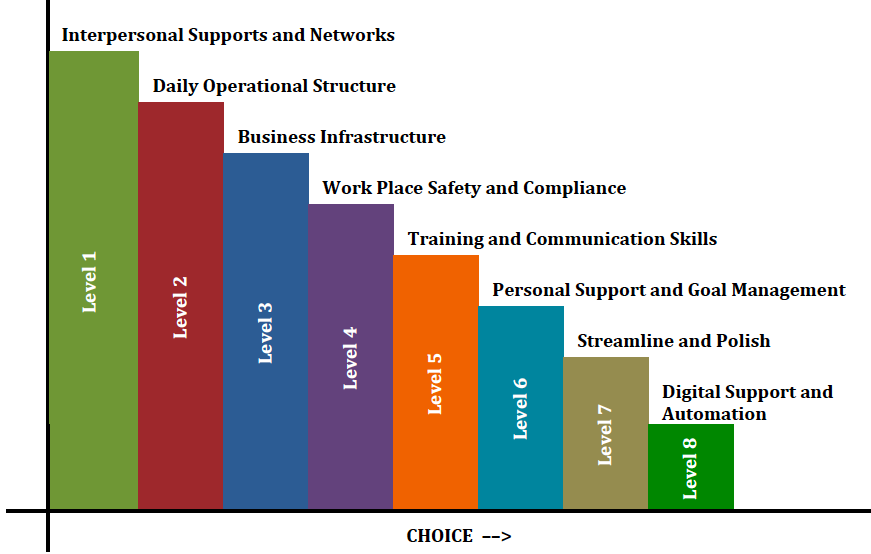This is an overview of many of the areas you will eventually come across and need to navigate. Some areas you will be stronger in than others, and by having people around you to call on when you need it you can create a solid and supportive business structure and personal network. It is unrealistic to think you can have this all sorted and shelved, as it is an ever changing arena of needs and governance, some of which are personal changes and some are influenced by external sources. This is a guide and invitation to find your strengths and opportunity to see where you may need help.
8 Levels towards independent choice, control of services, and a Best Practice standard of operations.
The steps are described below, and in detail on this website. They build on themselves yet have no set order, you may have some aspects well sorted and other areas maybe unconsidered as yet or need more work.

Level 1
Personal Networks – Consider your needs and the roles you require for support, then start a discussion with those closest to you and begin the discovery of who and what is possible. Connect with people you know, those who can and will help you when you need it. Those who are able to understanding or willing to learn what you need and how to enable your life choices.
Family
Friends
Associates
Financial Business Networks – make contact and enquire as to the role they play in the employment world. Fair work, Australian taxation office, ASIC, work safe, chamber of commerce they all offer skills and information you may not have yet or complement those you do.
Mentors
Advocates
Advisors
Groups
Financial Contacts
ATO –PAYG registration, lodge a Workers Tax File Number
Fair Work – wage requirements, work conditions
Super Payment set up (Unique Super Identifier)
Work Safe Australia – Occupational Health and Safety guidelines
Workers Compensation – each state is governed differently for this site we will consider iCare which governs NSW. Workers compensation offer financial help when workers get hurt or injured on the job. They will help to calculate approximate payment amounts for workers insurance cover. Then you or your book keeper will send a report to them showing actual employee wage amounts, (this is often as simple as a software generated report) which will determine if you will be credited or owe for insurance costs.
Book Keepers – offer for a fee to set up a frame work for running costs, chosen service information, workers data input and payroll needs. They basically chart expenses and payments made, and help with reports for your tax return purposes.
Accountants – charge for services and reports, and for the setting up of legal requirements. They usually offer companies or complex income and financial advice. ( A good book keeper is often as inform if your situation is simple or will tell you when it is beyond their capacity and refer to an advisor or help.)
Chamber of Commerce – have a Membership Fee, and offer information and some support services within your membership. This is an annual charge and included services do not roll over to the following membership.
Insurance – worker compensation is considered a minimum but home and contents can have a component of public liability inclusive.
Bank Account – used only for NDIS funding. Some charge fees and shopping around is advisable.
Level 2
For your use and those who come to support you, good record keeping systems and procedures allow efficient use of time and effectively get tasks done with the most ease and safety. Consider having the following –
Your Equipment details
-Suppliers details and contacts
-Specifications of each item you require
-Repair processes and contacts, who for what
-Repair time frames
Your specific Medical Matters
-Your regular contact people and phone numbers
-Designated communication and medical log
-Prescriptions and a medication profile
-Health Care Plans
-Procedures for medical episodes or events
-Policies
-Emergency contacts list
Level 3
Business infrastructure these are areas you will need directives and or processes to acquire and keep required legal records.
Record-keeping – finances, banking, wages and time-sheets, bookkeeping, staff review processes, human resource records, internal communications, and personnel files.
Recruitment- advertisement and places or platforms for position descriptions, job descriptions, phone interview questions, main interview questions, a selection process and or team, letters of acceptance or decline.
Induction- employment terms and conditions, service and costings contracts, Personnel HR details , tax forms statement, induction manual, human resource paperwork and workers acknowledgment records.
Orientation – covers occupational work health and safety basics, staff training, and some procedures.
Termination – warning processes and supporting letters, a dismissal letter, worker statement or reference.
HR and bits – carer contacts and support numbers or service contacts.
General Miscellaneous Office paper work or logs for paper trails
Level 4
The Manuals referred to here are the documents that detail how you run your business in keeping within the laws that govern employment and human relations, they explain the way and reason you want things to be done.
A Business Manual–details the main aspects of governance relating to employment terms and conditions. All policy and procedures with accompanying letters and supporting checklists or forms that relate to financial record keeping requirements and payments.
Orientation manual – covers initial engagement records, office (HR) paper work for payroll and records, codes of conduct and expected behaviour standards; environmental orientation, and vehicle use.
Induction – covers worker safety matters and can be added to personalised and altered as requirements arise.
Manual handling
Hoist use
Medical emergency
Evacuation procedure
Disease Transmission
Medication administering, reporting, and personal use profile
Personal Health Care requirements and plans
Level 5
These are documents you may choose to create and use for your own functional purposes, as you move to build your workers skill base and competence.
Communication –
Shift and Medical log
Worker training log
Employer training record and lesson plans
Certificate renewal schedule – for workers so you know when they need a new first aid or police check redone.
Safety and Compliance schedule so your regularly checking in and keeping matters up to date
Equipment and environment checks,
Training and procedural trial runs,
Workers drill practice.
HR processes, in place for incidences, grievances or complaints
Level 6
Bookings
Rosters
People Skills
Worker training – modules, drills, updates
Team Building – ideas for exercises, tasks, and adventures that support a cohesion and trust building in working relationships.
Level 7
Five S’s – Sort, Set in order, shine, standardise, sustain. Apply this directive across all areas of your personalised working arenas for maximum efficiency and ease of use.
Level 8
Digital automation, you may choose to use digital software for accounting, staff management, rostering etc. There are many out there and worth exploring if you can benefit from them and computers work for you.
Cyber Security, – all I can say is choose reputable over well marketed.
Information Storage – protect the work you put in and keep your records backed up within an external source or a separate hard drive, and if you choose in the cloud.
